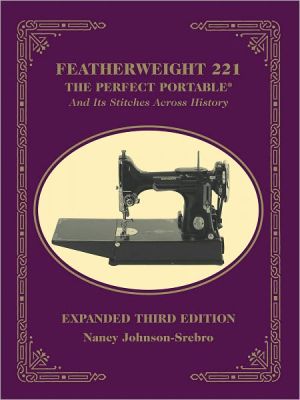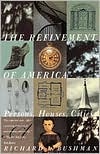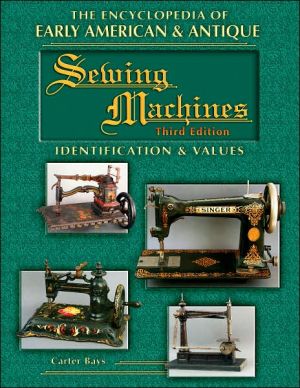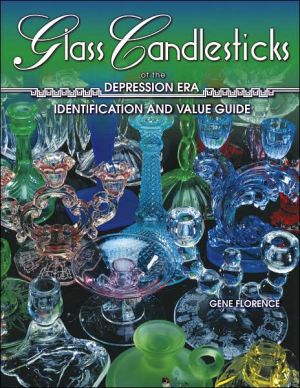Findings: The Material Culture of Needlework and Sewing
Mary C. Beaudry mines archaeological findings of sewing and needlework to discover what these small traces of female experience reveal about the societies and cultures in which they were used. Beaudry’s geographical and chronological scope is broad: she examines sites in the United States and Great Britain, as well as Australia and Canada, and she ranges from the Middle Ages through the Industrial Revolution.\ The author describes the social and cultural significance of “findings”: pins,...
Search in google:
Mary C. Beaudry mines archaeological findings of sewing and needlework to discover what these small traces of female experience reveal about the societies and cultures in which they were used. Beaudry’s geographical and chronological scope is broad: she examines sites in the United States and Great Britain, as well as Australia and Canada, and she ranges from the Middle Ages through the Industrial Revolution.The author describes the social and cultural significance of “findings”: pins, needles, thimbles, scissors, and other sewing accessories and tools. Through the fascinating stories that grow out of these findings, Beaudry shows the extent to which such “small things” were deeply entrenched in the construction of gender, personal identity, and social class.
Findings\ The Material Culture of Needlework and Sewing \ \ By Mary C. Beaudry \ Yale University Press\ Copyright © 2006 Yale University\ All right reserved.\ ISBN: 978-0-300-11093-7 \ \ \ Chapter One\ Introduction \ Small Finds, Big Histories\ My interest in the material culture of needlework and sewing began in the early 1990s, with the slowly dawning realization that many items I was finding at the Spencer-Peirce-Little Farm in Newbury, Massachusetts, the site I had been excavating since 1986, were artifacts related to sewing. Each season we found one or more thimbles and many straight pins; every so often we recovered a pair of sewing scissors. The 1993 season turned up several objects we could not identify at first, among them a carved bone bobbin that, I later learned, was used to make lace. That year we also found a silver thimble with a monogram. It occurred to me that such a valued personal object could serve as the point of entry for learning about the women who once lived at this site, women about whom both the documentary and archaeological records thus far have been disappointingly un-informative.\ Although I had watched my mother sew and had learned embroidery when young, I was a spectacular failure in the sewing portion of the home economics course I was required to take in high school. Notbeing inclined to pursue activities that I am not good at, I have since avoided sewing anything. And so my understanding of sewing and its associated paraphernalia was rudimentary, even though I often excavated sites at which generations of women had spent much of their lives sewing, mending, making lace, and the like. Their pursuits were largely invisible to me because I did not recognize the implements used in such work for what they were. Like most of us, I knew a pin or a needle or a thimble-and certainly a pair of scissors-when I saw one, or even part of one. But there my knowledge ended. I could only guess at the identification of other objects, especially if they were not part of the great trinity of historical archaeologists' artifacts: ceramics, clay pipes, and glass.\ Excavated artifacts of needlework and sewing-pins, needles, thimbles, and so on-fit quite naturally, albeit often anonymously, into the category of "small finds." Although the phrase is more likely to be used by excavators working within the British archaeological idiom than by American historical archaeologists, a state of mind pervades the field as a whole that has led to acceptance of a narrow set of conventions in thinking and writing about small finds.\ Historical archaeologists tend to assume, without giving it much thought, that ceramics, glass, clay pipes, and animal bones are more informative and hence of far greater interest than many other sorts of finds, and they have developed useful and widely employed conventions for presenting, analyzing, and interpreting those categories of material. Yet even though historical archaeology has burgeoned over the past four decades and is now practiced all over the globe, huge gaps remain in our knowledge of the material culture of medieval, early modern, and modern times. The frequent reprinting of Ivor Noël Hume's Guide to Artifacts of Colonial America, the appearance of Kathleen Deagan's two volumes devoted to artifacts of the Spanish colonies, and the publication in 2000 by the Society for Historical Archaeology of a volume of artifact studies and of a second edition of a collection of artifact studies reprinted from its journal, Historical Archaeology, are ample proof that we hunger for more information about the artifacts we dig up.\ The increased interest in gender analysis among historical archaeologists has given rise to greater interest in objects that might be related to women and, especially, to women's activities. This has led since the early 1990s to attempts to fill the gaps and remedy the silences of finds analysis by seeking out objects that have not been studied because they were deemed trivial for the very reason that they were associated with women's domestic activities. Because sewing is so universally associated with women, artifacts of needlework and sewing often stand as evidence of women and women's activities. The link is based in part on reality but also on uncritical assumptions about sewing and how sewing ties in with the lives of both men and women.\ Throughout history, activities customarily performed either by men or by women have become associated with and deemed appropriate to members of one sex or the other. Through such customary associations various undertakings and responsibilities have become culturally designated as the "natural" province of one sex or another and therefore integral to the definition of gender identity through designation of gender roles. The processes, settings, tools, and materials employed in an enterprise are metonymically transformed into symbols of sex-specific tasks and so become emblems of gender identity (fig. 1.1).\ Gender identity can be constructed and negotiated (as opposed to being simply assigned). Archaeologist Barbara Luedtke wrote that it is important to attend to the possibility, if not likelihood, that "the meaning of our archaeological artifacts ... varied with context." In this book I explore, through the example of the artifacts of needlework and sewing, ways in which gender identity can be signaled and can shift according to context. These issues can be examined by reconstructing, through critical analysis of documentary and pictorial sources, the ethnographic contexts in which sewing and needlework served practical ends and those in which sewing and needlework implements featured as symbols in myth or ritual or as expressions of sentiment in society; by examining the classificatory logic underpinning the "gendered" nature of sewing; and by close readings of instances in which the "usual" symbolic import of sewing implements is subverted through symbolic inversion and anomaly.\ Feminist art historian Rozsika Parker, in her groundbreaking work The Subversive Stitch, examines how "embroidery has become indelibly associated with stereotypes of femininity"-femininity being a "crucial aspect of patriarchal ideology." She demonstrates through detailed analysis of works-written and stitched-by both men and women that "the development of an ideology of femininity coincided historically with the emergence of a clearly defined separation of art and craft." The division began during the Renaissance, at a time when embroidery was done more and more by women working in the home rather than by professional, usually male, embroiderers. During the seventeenth century, embroidery was used to inculcate femininity in young girls, so much so that "the ensuing behaviour appeared innate." An ideology of femininity as natural to women evolved in the eighteenth century, and from the eighteenth century on, embroidery came to signify femininity as well as a leisured, aristocratic life-style, proof of gentility because of its association with nobility,\ providing concrete evidence that a man was able to support a leisured woman. Moreover, because embroidery was supposed to signify femininity-docility, obedience, love of home, and a life without work-it showed the embroiderer to be a deserving, worthy wife and mother. Thus the art played a crucial part in maintaining the class position of the household, displaying the value of a man's wife and the condition of his economic circumstances. Finally, in the nineteenth century, embroidery and femininity were fused and the connection was deemed to be natural. Women embroidered because they were naturally feminine and were feminine because they naturally embroidered.\ But, Parker notes, though many women may have "colluded" in the continuance of this construction of gender identity, they were not always passive recipients of such ideologies but responded to them: women used these ideologies and were used by them. Over the centuries, embroidery has provided support and satisfaction for women and has served as a covert means of negotiating the constraints of femininity; women were able to make meanings of their own while overtly living up to the oppressive stereotype of the passive, silent, vain, and frivolous, even seductive needlewoman. Parker's eye-opening study provides the framework for my examination of the material culture of fancy needlework alongside the artifacts of ordinary sewing.\ Consider for a moment the likelihood that complex civilizations could have arisen if no one had invented cordage for tying up bundles, creating strings from fibers that could be manipulated in many ways, knotted, netted, laced through skins, woven into cloth. If women had never experimented with fibers, if this experimentation had never led to textile production, to clothing, tapestries, blankets, bags, coverings of all sorts, the course of civilization, if indeed there was any, would be unimaginable, unthinkable. Textile production and sewing of some sort have been tangled up with aspects of culture-technological, social, economic, ritual, and so on-since early in human history. As a result, the products of weaving and needlework, the tools used in these processes, and the persons who undertook these activities were enmeshed in a system of symbols with multiple meanings. The job of the archaeologist, as I see it, is to investigate the cultural complex of sewing in order to explore how needlework implements carried meaning in specific historical and cultural contexts and then to place these carefully constructed cases into wider cultural contexts.\ Needlework held both homey and utilitarian as well as broader social consequence. Spinning, sewing, mending and remaking garments, and marking sheets, towels, and other linens was a regular component of household work done or overseen by women. Genteel women and girls engaged in fancy or decorative needlework as testimony to their skill in the feminine arts as well as to a social position that permitted leisure for such nonutilitarian pursuits. At the same time, not all fancy needlework was a pastime for wealthy women of leisure, nor was all utilitarian sewing destined for immediate household use. Many a needle-woman depended on the income her handiwork could generate. Knowing this, it is clear that the artifacts of needlework from historical sites can be interpreted along several lines of social and economic relevance: everyday, "practical" or "necessary" work (sewing, mending, and knitting); "fancy work" (embroidered pictures, muslin or "whitework," cutwork, candlewicking, tambour work, stuffed work, canvas work, and so on); and work of either sort produced for sale outside the home. Attention to the type, quality, and intended functions of the artifacts of needlework and sewing makes it possible to address the issues of the nature or quality of sewing activity and to relate this to household income and management strategies, to social standing and social display, and to the construction of gender identity.\ In the collections of the Historical Society of New Hampshire there survives a wonderful embroidered picture (fig. 1.2). It was done in 1734 by Jane Peirce when she was five years old. Jane was one of seven children of Charles Peirce and Sarah Frost, and she grew up in the Spencer-Peirce-Little House, on the farm where I have spent so many seasons excavating. The embroidered picture is a rare and marvelous survival, tangible evidence of needlework in service to the inculcation of and construction of feminine identity. In the chapters that follow I explore ways of identifying and interpreting the needlework tools archaeologists commonly find; in my case, I am hoping that the knowledge I have accumulated will help me understand the sewing implements excavated from the soils around the house where young Jane stitched her canvaswork picture and to reconstruct a more complete picture of the generations of women who plied their needles at the Spencer-Peirce-Little Farm. But I am hopeful that the guidelines I provide will prove useful for other archaeologists, and I have sought out many additional case studies beyond my own site to provide examples of how differing contexts lead to differing interpretations.\ My approach is broadly interpretive, and my aim is to move past the ostensibly simple first steps of artifact identification and dating and even beyond "engendering" artifacts by bringing multiple lines of evidence to bear on the interpretation of the material culture of sewing and needlework in the "active voice." An interpretive approach acknowledges that material culture is not just something people create but an integral component of our personalities and our social lives, deeply implicated in how we construct social relationships. Trying to comprehend what things meant to people in the past is not the most easily undertaken task, but it is not altogether impossible, especially not for historical archaeologists. My goal is to construct a rich contextual analysis of how women and men used objects of needlework and sewing and to consider the multiplicity of meanings these everyday items conveyed. Sometimes the best way to do this is to try to reconstruct the stories in which people and their things played active roles, to construct narratives that ground interpretation in the everyday lives of people in the past and in the life histories of the objects that archaeologists find otherwise mute or mysterious and strangely distant.\ I see the analysis of documentary evidence as vital to constructing the interpretive ground, as it were, for artifact analysis. This is why, throughout this book, I offer case studies that track back and forth among documents and artifacts to offer interpretations that arise from the combined evidentiary sources. Alison Wylie has described this process as one of constructing cables of inference; her metaphor is a powerful one and aptly captures what I am attempting to accomplish.\ An important step in the research process involves casting a wide net through primary and secondary sources to learn generally about the importance of needlework in women's (and men's) lives. This involves knowing what articles different needlework tools were used to produce and their social, cultural, and economic significance, the contexts of production, and the social implications of different forms of needlework. It is clear that cloth production, sewing, and needlework played an important part in the lives of most women throughout history and that the implements of these activities, because they were associated with women, often served as symbols of women's status and women's role.\ Consider the seemingly most obvious and most trivial of all small finds-the common straight pin and the not-so-logical syllogism about pins that one often encounters in the literature. Pins equal sewing, or so most archaeologists assume; they also assume that sewing was done by women. Therefore, pins = sewing = women. But, as I explore in chapter 2, common straight pins were used to fasten both men's and women's clothing, to fasten documents, to fasten shrouds, to serve as guides for thread in lace-making, to conjure spells and to ward against them; in other words, pins were used for many purposes beyond sewing. And it is sometimes possible to differentiate what these purposes might have been, since pins were made in varied sizes because different sizes were needed for the diverse purposes I've mentioned. But because we think we "know" what pins mean, we do not pay them much attention. A typical illustration in an archaeological report will show a small pile of pins from various contexts at a given site carefully set beside the other items the archaeologists assume are women's things or part of the sewing assemblage.\ In the following chapters, I examine items of the material culture of needle-work and sewing that are most likely to survive in archaeological contexts: pins (chapter 2); needles (chapter 3); thimbles (chapter 4); scissors (chapter 5); and less common items associated with weaving, lace-making, and the finishing of garments (chapter 6). I focus on implements or tools; I do not consider textiles except as they relate to sewing, and I do not consider buttons because although they are sewn onto clothing and usually serve as fasteners, in my mind they are not tools of needlework but functional clothing fasteners, items of personal adornment, or both. (Continues...)\ \ \ \ \ Excerpted from Findings by Mary C. Beaudry Copyright © 2006 by Yale University. Excerpted by permission.\ All rights reserved. No part of this excerpt may be reproduced or reprinted without permission in writing from the publisher.\ Excerpts are provided by Dial-A-Book Inc. solely for the personal use of visitors to this web site. \ \
Contents Acknowledgments....................ixONE Introduction: Small Finds, Big Histories....................1TWO The Lowly Pin....................10THREE The Needle: "An Important Little Article"....................44FOUR The Ubiquitous and Occasionally Ordinary Thimble....................86FIVE Shears and Scissors....................115SIX Findings: Notions, Accessories, and the Artifacts of Textile Production....................137SEVEN Stitching Together the Evidence....................169Notes....................179References....................207Index....................227








